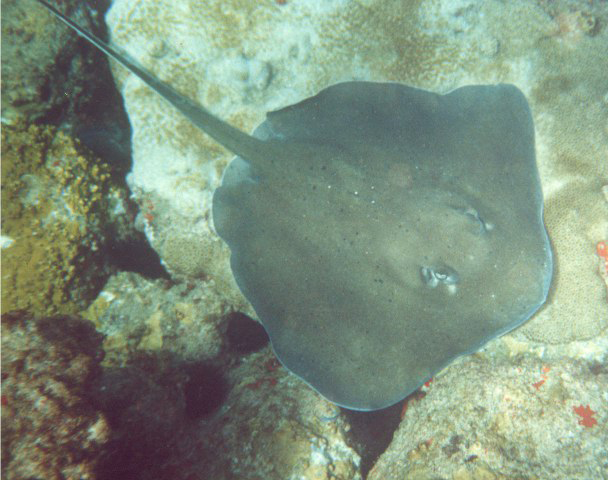| Dasyatidae (Stingrays), subfamily: Dasyatinae |
| 300 cm TL (male/unsexed); max.weight: 300 kg |
|
demersal; brackish; marine; depth range 3 - 270 m |
| Western Atlantic: antitropical; from western and southern USA, including the Gulf of Mexico, and Brazil to Argentina (Ref. 114953). Eastern Atlantic populations refer to Bathytoshia lata (Ref. 109651, 114953). |
|
Diagnosis: Large specimens of Dasyatis centroura are recognizable by their thorny tails, by the large size and wide spacing spacing of their mid-dorsal bucklers, and by the conspicuous tubercles or bucklers on the outer parts of their discs; in smaller specimens the large tubercles have not yet developed on the tail (Ref. 6902). It differs from Dasyatis sabina, D. guttata and Himantura schmardae in the shape of disc; it resembles Dasyatis say and D. americana in shape of disc, but it can be distinguished from D. say by the fact that the tail lacks any trace of a cutaneous fold above, and from D. americana by its much narrower ventral tailfold (Ref. 6902).
Description: A very large stingray; disc rhombic, the anterior margins forming a blunt angle (Ref. 6902, 39859, 81259). Dorsal surface entirely, but irregularly rough, with a mid-dorsal row of large thorny tubercles provided with striate bases and erect cusps; a few similar tubercles scattered over pectoral fins and head (Ref. 81259). Tail whip-like and strongly spinous, with numerous rows of small spines; tail with a short dorsal ridge behind the sting and a poorly developed ventral fold, which is long long, but quite low and not easily seen (Ref. 7251).
Colouration: Dorsal side dark brown to olivaceous-brown; the lower surface whitish, with or without dark pectoral margins; tail blackish behind the sting (Ref. 6902, 81259). |
| Dasyatis centroura is a coastal species (Ref. 81259), found over sandy and muddy bottoms (Ref. 3169). It feeds on bottom-living invertebrates and fishes (Ref. 3169). Ovoviviparous (Ref. 6901). Wings marketed fresh, smoked, dried-salted; used for fishmeal and oil. Harmful to shellfish banks; dangerous to bathers and fishers due to its poisonous spine. May attain well over 100 cm TL. Warm season visitor to coastal waters (Ref. 6902). |
|
Vulnerable (VU); Date assessed: 21 June 2019 (A2d) Ref. (130435)
|
| venomous |
Source and more info: www.fishbase.org. For personal, classroom, and other internal use only. Not for publication.

